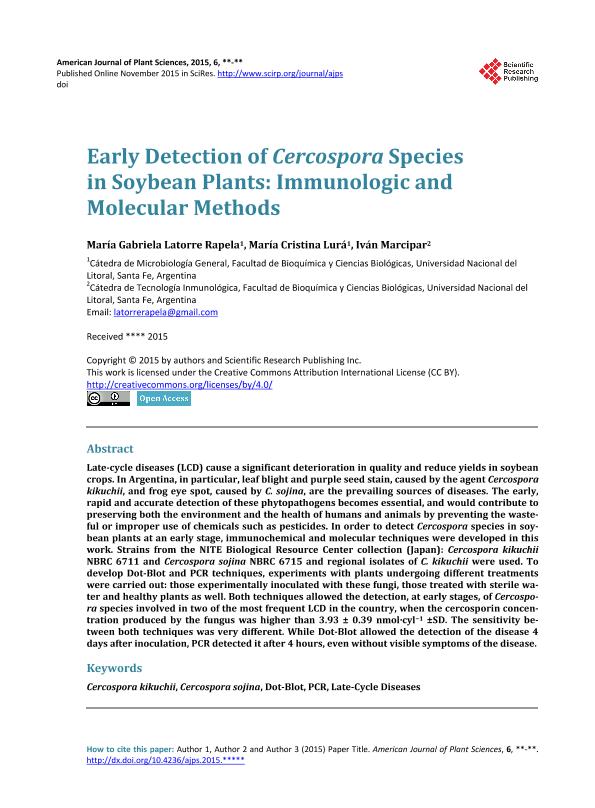Mostrar el registro sencillo del ítem
dc.contributor.author
Latorre Rapela, María Gabriela de Los Milagros

dc.contributor.author
Lura, Maria Cristina Enriqueta

dc.contributor.author
Marcipar, Iván Sergio

dc.date.available
2018-04-09T18:13:14Z
dc.date.issued
2015-11
dc.identifier.citation
Latorre Rapela, María Gabriela de Los Milagros; Lura, Maria Cristina Enriqueta; Marcipar, Iván Sergio; Early Detection of Cercospora Species in Soybean Plants: Immunologic and Molecular Methods; Scientific Research Publishing; American Journal of Plant Sciences; 6; 18; 11-2015; 2939-2948
dc.identifier.issn
2158-2742
dc.identifier.uri
http://hdl.handle.net/11336/41364
dc.description.abstract
Late-cycle diseases (LCD) cause a significant deterioration in quality and reduce yields in soybean crops. In Argentina, in particular, leaf blight and purple seed stain, caused by the agent Cercospora kikuchii, and frog eye spot, caused by C. sojina, are the prevailing sources of diseases. The early,rapid and accurate detection of these phytopathogens becomes essential, and would contribute to preserving both the environment and the health of humans and animals by preventing the wasteful or improper use of chemicals such as pesticides. In order to detect Cercospora species in soybean plants at an early stage, immunochemical and molecular techniques were developed in this work. Strains from the NITE Biological Resource Center collection (Japan): Cercospora kikuchii NBRC 6711 and Cercospora sojina NBRC 6715 and regional isolates of C. kikuchii were used. To develop Dot-Blot and PCR techniques, experiments with plants undergoing different treatmentswere carried out: those experimentally inoculated with these fungi, those treated with sterile water and healthy plants as well. Both techniques allowed the detection, at early stages, of Cercospora species involved in two of the most frequent LCD in the country, when the cercosporin concentration produced by the fungus was higher than 3.93 ± 0.39 nmol∙cyl−1 ±SD. The sensitivity between both techniques was very different. While Dot-Blot allowed the detection of the disease 4 days after inoculation, PCR detected it after 4 hours, even without visible symptoms of the disease.
dc.format
application/pdf
dc.language.iso
eng
dc.publisher
Scientific Research Publishing
dc.rights
info:eu-repo/semantics/openAccess
dc.rights.uri
https://creativecommons.org/licenses/by/2.5/ar/
dc.subject
Cercospora Kikuchii
dc.subject
Cercospora Sojina
dc.subject
Dot-Blot
dc.subject
Pcr
dc.subject.classification
Otras Ciencias Biológicas

dc.subject.classification
Ciencias Biológicas

dc.subject.classification
CIENCIAS NATURALES Y EXACTAS

dc.title
Early Detection of Cercospora Species in Soybean Plants: Immunologic and Molecular Methods
dc.type
info:eu-repo/semantics/article
dc.type
info:ar-repo/semantics/artículo
dc.type
info:eu-repo/semantics/publishedVersion
dc.date.updated
2018-03-26T18:24:41Z
dc.identifier.eissn
2158-2750
dc.journal.volume
6
dc.journal.number
18
dc.journal.pagination
2939-2948
dc.journal.pais
Estados Unidos

dc.description.fil
Fil: Latorre Rapela, María Gabriela de Los Milagros. Universidad Nacional del Litoral. Facultad de Bioquímica y Ciencias Biológicas; Argentina
dc.description.fil
Fil: Lura, Maria Cristina Enriqueta. Universidad Nacional del Litoral. Facultad de Bioquímica y Ciencias Biológicas; Argentina
dc.description.fil
Fil: Marcipar, Iván Sergio. Universidad Nacional del Litoral. Facultad de Bioquímica y Ciencias Biológicas; Argentina. Consejo Nacional de Investigaciones Científicas y Técnicas. Centro Científico Tecnológico Conicet - Santa Fe; Argentina
dc.journal.title
American Journal of Plant Sciences
dc.relation.alternativeid
info:eu-repo/semantics/altIdentifier/doi/http://dx.doi.org/10.4236/ajps.2015.618289
dc.relation.alternativeid
info:eu-repo/semantics/altIdentifier/url/http://file.scirp.org/Html/15-2602280_61439.htm
Archivos asociados
